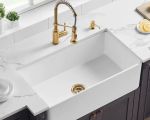- 1 - Space Planning for Laundry Room
- 2 - Storage Solutions and Smart Organization
- 3 - Enhancing Efficiency through Layout Design
- 4 - Practical Examples and Personal Insights
- 5 - Reliable Sourcing for Laundry Room Products
1. Space Planning for Laundry Room
Organizing your laundry room space begins with a thoughtful approach to planning. The first step is to evaluate the size and shape of your room, identifying key zones such as washing, drying, folding, and storage areas. A common challenge in laundry rooms is limited space, which can make efficient layout essential. Prioritizing zones based on frequency of use helps in setting up an intuitive workflow that saves time and reduces frustration. For example, positioning your washer and dryer side by side with adjacent counter space for folding clothes can drastically improve the usability of the room.
Moreover, vertical space is often underutilized. Installing wall-mounted shelves or cabinets above machines can provide ample storage without sacrificing floor space. In smaller laundry rooms, consider compact or stackable washer-dryer units to free up room for other organizational features. The goal is to transform the laundry area from a cramped, cluttered spot into a well-structured, functional workspace that supports your daily routine.
2. Storage Solutions and Smart Organization
Storage is key when organizing your laundry room space effectively. Smart organization involves selecting storage solutions tailored to your needs, such as open shelving for detergents and frequently used items, and closed cabinetry to hide away cleaning supplies and tools. Incorporating baskets or bins labeled by category helps keep smaller items from becoming lost clutter.
One highly effective strategy is to designate a “laundry station” that includes essentials like stain removers, fabric softeners, and laundry bags, all kept within arm’s reach. This reduces time spent searching for items and keeps the space tidy. Additionally, installing a hanging rod or retractable clothesline enables air drying delicate garments, while foldable drying racks can be stored away when not in use.
Another idea is to use multi-purpose furniture such as storage benches or carts with wheels. These can provide extra storage, seating, and flexibility in layout. Choosing clear containers for powders and pods not only looks visually appealing but also prevents messes and spills, promoting a clean and efficient laundry environment.
3. Enhancing Efficiency through Layout Design
Beyond storage, the layout of your laundry room can have a significant impact on efficiency. Ideally, create a smooth flow from dirty clothes to clean, folded garments ready for storage. Placing hampers or sorting bins near the washer streamlines the initial step of laundry. Then, having a flat surface or folding table nearby encourages immediate handling of clothes, reducing piles and wrinkles.
Lighting also plays a crucial role in making your laundry room a pleasant workspace. Adequate task lighting over folding areas and bright, evenly distributed lighting overall can make sorting and stain spotting easier and less stressful. Additionally, consider incorporating durable, easy-to-clean surfaces such as quartz countertops or laminated cabinetry that stand up to moisture and frequent use.
Some homeowners have shared how a slight reconfiguration—like adding a pull-out ironing board or a small sink for hand washing—transformed their laundry experience. These additions, while minor, contribute to a highly functional space tailored to personal habits.
4. Practical Examples and Personal Insights
One inspiring story comes from a homeowner who transformed a cluttered laundry closet into a streamlined, efficient room by embracing vertical organization and multitasking furniture. By installing floor-to-ceiling shelves and using labeled bins, she created a system that eliminated hours of searching for lost items and increased her laundry throughput. Her advice: “Invest in storage that fits your specific needs rather than buying generic solutions.”
Another example is a small apartment where space was extremely limited. The occupant opted for a stacked washer and dryer unit and installed a fold-down countertop that doubles as a folding station. Hooks for hanging cleaning supplies were placed on the door, using every inch wisely. These personalized adaptations highlight how tailoring the laundry room to individual constraints and habits results in better usability and satisfaction.
Such real-life stories underline that organizing your laundry room space is not just about aesthetics but also about creating a workflow that feels natural and sustainable. Small changes can make a big difference in daily efficiency and stress reduction.
5. Reliable Sourcing for Laundry Room Products
Finding the right products to organize your laundry room space can be overwhelming given the wide variety of options available. To ensure you invest in durable and effective solutions, visiting trusted platforms like Improvement is a great way to explore curated selections of storage systems, organizational tools, and space-saving furniture. Improvement offers personalized recommendations to match your room’s size, style, and functionality needs, making your project easier and more successful.
Moreover, seeking expert advice on such platforms helps avoid costly mistakes from purchasing incompatible or low-quality items. Whether you are upgrading an entire laundry room or just optimizing a small nook, having access to professional guidance and reliable products adds confidence to your organization journey.
Ultimately, organizing your laundry room space is a process that combines smart planning, tailored storage solutions, efficient layout, and quality product choices. By applying these insights and drawing inspiration from real-life examples, you can transform this essential household area into a highly functional and enjoyable part of your home.








